Standard [CURRENT]
ASTM E 2923:2024
Standard Practice for Longevity Assessment of Firestop Materials Using Differential Scanning Calorimetry
- Publication date
- 2024
- Original language
- English
- Pages
- 5
- Publication date
- 2024
- Original language
- English
- Pages
- 5
- DOI
- https://dx.doi.org/10.1520/E2923-24
Product information on this site:
Quick delivery via download or delivery service
Buy securely with a credit card or pay upon receipt of invoice
All transactions are encrypted
Short description
1.1 This practice covers a standardized procedure for quantitatively assessing the longevity of materials used in firestop systems, by the use of data obtained from differential scanning calorimetry. 1.2 This practice is intended to differentiate firestop materials that are expected to maintain performance characteristics over time from those that are expected to degrade in performance characteristics over time. DSC experimental curve evaluation can also deliver indifferent results, where an interpretation of sample properties is not possible without additional testing using conventional durability testing. It evaluates the extent of chemical reactions that will occur within the firestop material under specified conditions of temperature and humidity. This practice does not measure longevity under specific severe environmental conditions or building operation that might be experienced by an individual firestop system. 1.3 This practice is intended to be used to validate an expectation of longevity for materials that are used within a firestopping system. The practice is not intended to be used to gauge the performance of artificially aged materials in a firestop test. The method described herein cannot be applied as a preconditioning of a material meant for a firestop test due to the size limitation of the test specimen and the nature of the test itself. 1.4 This practice is intended to evaluate the following types of materials used in through-penetration fire stops: 1.4.1 Endothermic, 1.4.2 Intumescent, 1.4.3 Insulation, 1.4.4 Ablatives, and 1.4.5 Subliming. 1.5 The values stated in SI units are to be regarded as standard. No other units of measurement are included in this standard. 1.6 This standard does not purport to address all of the safety concerns, if any, associated with its use. It is the responsibility of the user of this standard to establish appropriate safety, health, and environmental practices and determine the applicability of regulatory limitations prior to use. Some specific hazards are given in Section 8 on Hazards. 1.7 This international standard was developed in accordance with internationally recognized principles on standardization established in the Decision on Principles for the Development of International Standards, Guides and Recommendations issued by the World Trade Organization Technical Barriers to Trade (TBT) Committee.
ICS
13.220.20
DOI
https://dx.doi.org/10.1520/E2923-24
Also available in
Loading recommended items...
Loading recommended items...
Loading recommended items...
Loading recommended items...

